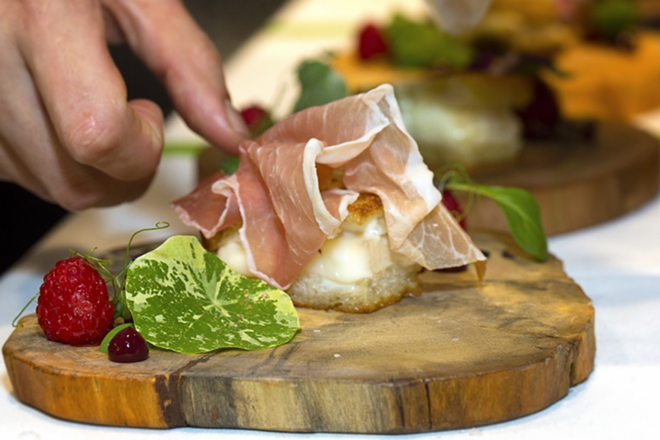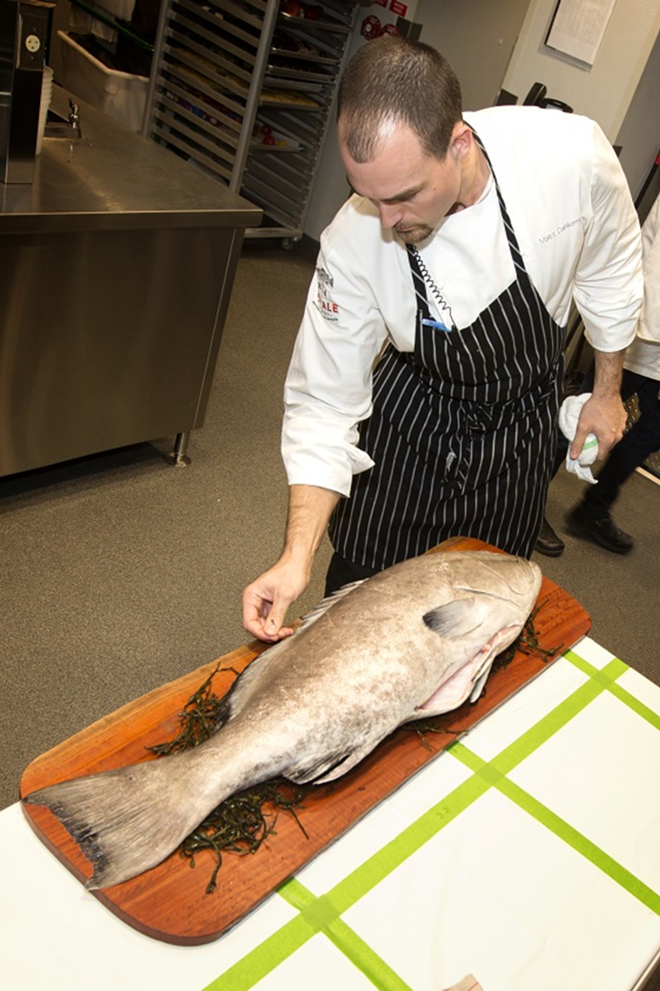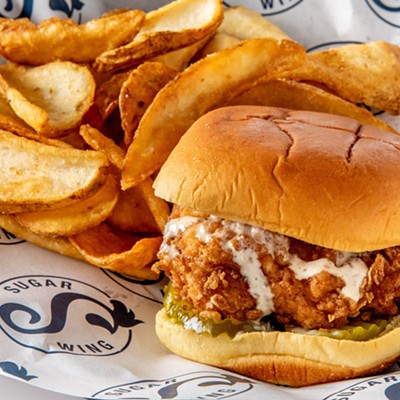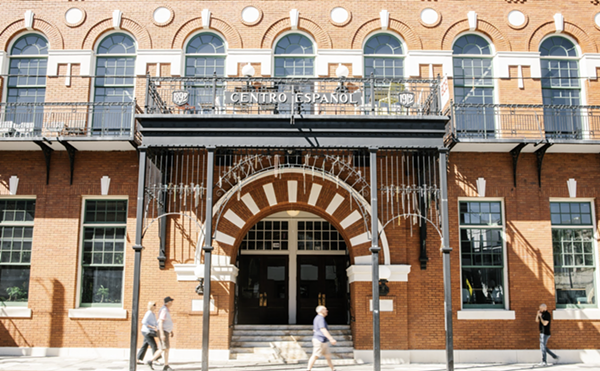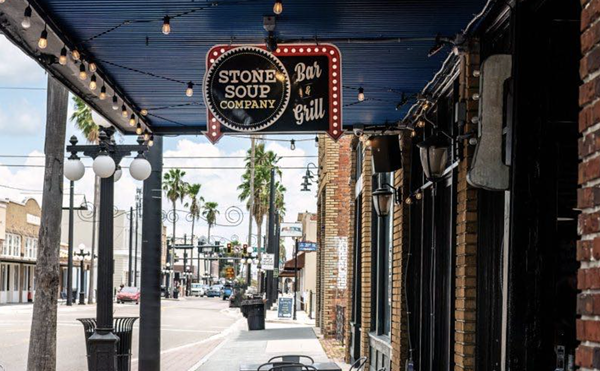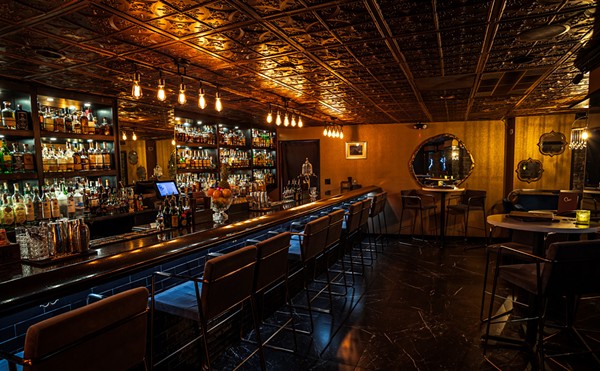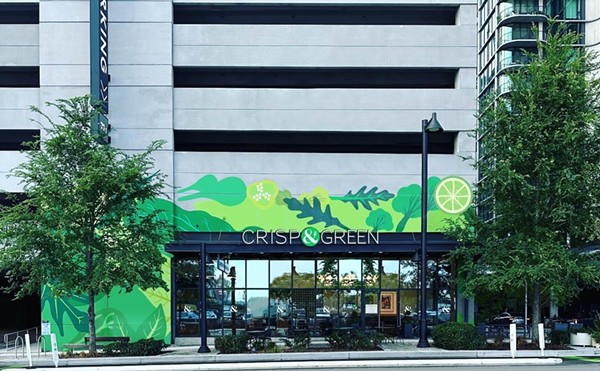There's plenty of wonderful food in the Tampa Bay region, and it’s a joy to bounce around the bay sampling the culinary bounty. But few restaurants aspire to true greatness — pushing boundaries, incorporating new techniques or ingredients that pull diners up short. In CL’s star system, ranging from one (poor) to five (world-class), only William Dean Chocolates blindsides you with five-star flavors that say, “Forget Paris,” as tears of joy run down your gobsmacked cheek. I also found five-star treatment (and concomitant prices) at Victoria & Albert’s, but that’s two hours east at Disney’s Grand Floridian Resort & Spa.
So, can the new kid in town vault over the highest of bars?
Downtown St. Pete’s FarmTable Kitchen at the Sundial is the region’s first spot to adopt the “ticket” system pioneered by Chicago’s Next, where you prepay as you would for a play or concert; seating is in pairs. The ticket price is $105 each, plus tax and tip. If you add the truly exceptional wine pairings that are as exciting as the food (and, therefore, non-negotiable), you’re at a cool all-inclusive $205 per person. It’s a stretch from the norm in our region, but consider that these kinds of meals are up-close performances priced much lower than seats at, say, Beyoncé, Andrea Bocelli or the Fleetwood Mac reunion.
The evening begins with a glass of the Michael Mina Cuvée from Iron Horse Vineyards, one of Sonoma County’s iconic producers of distinctive, terroir-driven sparkling wines. Off you go, bubbles in hand, on an informative multi-kitchen tour — led by Gary FX LaMorte, one of the Mina Group’s “culinary ninjas” — through Locale Market’s 11 chef playgrounds.
There’s an enormous pasta machine that looks like it might perform cold fusion but instead produces row after row of silky, ethereal fresh noodles in every shape imaginable. And you come across the dry-aged meat locker lined with blocks of amber-hued Himalayan salt. You peer into a glass wall at the huge slabs of prime beef, shrinking and darkening, just as surely as an old couple on a Greek beach. Luckily, in the case of beef, you can trim away the crust to produce an amazing edible sensation (see course No. 6 below).
After you ascend to the second floor to finish up your tour, you enter the inner sanctum: a splendidly rustic 10-seat communal farm table tucked off to the side past the wine bar. Let the show begin.
Course No. 1: “From the Fishmonger.” The opening salvo is a dramatic sashimi from the day’s catch. Chef Philip Darbyshire slaps a whole enormous fish down on his seafood-strewn butcher block at the end of the table. Depending on what gems are pulled from the net that day, you may get strawberry grouper, blackfin tuna or some other glistening Gulf treasure. Then begin the theatrics of breaking down the freshest of fish into melt-in-your-mouth sashimi. While that show is going on, chef LaMorte holds an inverted gas canister over every plate as it exudes a bright green basil-kale-watercress foam. He then grates fine, fresh Orlando tangerine zest on one side of the plate, and savory bottarga (sun-cured grey-striped mullet roe from the Anna Maria Fish Company just over the Skyway) on the other. We’re in a unique position to have access to this special product, which is usually only available around the Mediterranean, notably on the island of Sardinia. Some heat is added by Locale’s own togarashi (a Japanese chili pepper condiment). Topping it all is a deep-fried, free-form piece of golden brown semolina pasta that acts as a crackling on which to place the fish or dab the condiments.
This matches beautifully with Robert Weil’s Tradition, a Rhine valley riesling produced exclusively for the American market. It has intoxicating aromas of dried fruit, with peach and honey on the palate. The mouth-watering acidity leads to a crisp, clean finish.
Course No. 2: “Foraged/Garden.” Chef Thomas Shaw produces a platter of individual caponata servings from ember roasted eggplant, tomato fondue, garlicky bagna cauda and garden herbs sourced from specific local farms. The luscious mounds of soft, entwined veggies, each garnished with an upright young chive blossom, are served from the dish as it’s passed around the table.
Course No. 3: “Cheese & Salumi.” The menu proclaims the culinary truism that “what grows together, goes together.” Chef Paul Chung’s wooden cross-section-of-a-tree cheeseboard reflects that mantra with creamy aromatic taleggio cheese blanketed by nearly translucent “proscuitto [sic] di Parma.” It’s surrounded by a bed of nasturtium leaves with a single flower and two different strawberry garnishes (one has delicate, thin slices and the other is a thickened tart puree carefully daubed around the “plate”). Locale’s artisan olive loaf completes the tasty picture.
Both courses are paired with fresh, vibrant Au Bon Climat chardonnay. The slow ripening of the Santa Barbara grapes produces an Old World, Burgundian-style wine with light apricot, green apple and slate mineral notes. It rocks.
Course No. 4: “Italian Food Co.” Chef Jeffrey Hileman delivers three bite-size “rotolo di zuca [sic]” in a shiny, mini saucepan. These semolina pasta roulades are stuffed with a soft butternut squash, crushed amaretti cookie and Parmesan filling touched with nutmeg. They are sauced at the table as the chef spoons his truffle-laced, silken sottocenere cheese béchamel over the candied pumpkin seeds that garnish his creation. Though I adore the sauce, the rotolo strike me as gummy, and far too sweet for their place on the menu. They’d be much better off as a transition to dessert.
Thank heavens for Tablas Creek Vineyard’s Patelin de Tablas from Paso Robles, an area of California normally famous for its zinfandel. The synchronicity of this approachable blend of ripe Rhône valley grapes with the truffle-laced sauce vibrates on the palate.
Course No. 5: “The Intermezzo.” In lieu of a traditional sorbet, chef David Duong juxtaposes separate glasses of two impeccably fresh juice blends to refresh your taste buds: beets (which I normally avoid) with chiles, and ginger with turmeric. The result is surprisingly pleasant.
Course No. 6: “Butcher’s Block & Salt Locker.” The main attraction of Chef Matt Dahlkemper’s entree is 100 percent Angus beef from Niman Ranch’s “never-never” cows. The succulent prime meat has an all-vegetarian diet, and the cattle are never, never given antibiotics or added hormones, ever. Two rosy slabs of roasted, juicy eye of rib sit unadorned below an arc of natural jus. A family-style side of sliced, golden forono beets atop a tangle of wilted Faithful Farms greens demonstrates the wisdom of fresh and local, as does the house-made butter. The creamy texture and clean flavor, with just a touch of sea salt, is a simple pleasure with Locale’s sublime country garlic sourdough.
Diners not only get a chance to compare wet-aged versus 64-day dry-aged beef, but Château Coutet, a grand cru from Bordeaux’s St.-Émilion appellation, is poured side by side with Napa Valley’s “Chapellet [sic]” Mountain Cuvée. The Bordeaux’s dark berry fruit, hints of licorice and firm tannins match the dry-aged beef’s mushroom and blue cheese notes. And the Napa blend’s chewy, rustic style shows well with the less complex flavors of the wet-aged beef. This is a great opportunity to explore the subtleties of food-wine alchemy.
Course No. 7: “Pre-Dessert.” The rapid chill from liquid nitrogen (a darling of modernist cuisine) produces the creamiest imaginable Tahitian vanilla ice cream, which chef Randall Matthews douses with the bold punch of Lamill espresso.
Course No. 8: “Chocolatier.” The eight-layer deconstructed German chocolate cake from Mina's executive pastry chef, Lincoln Carson, is a lesson in classic pastry art. Imagine visiting a confectionary Grand Canyon where the geological strata are Valrhona Taïnori Dominican dark chocolate mousse with a vein of devil’s food and textured (yet silky) coconut cremeux — all dusted with a snow of powdered sugar. White chocolate cream dollops dot the landscape amidst candied pecan boulders.
The river in this sweet, hallucinatory landscape is a glass of Alvear Pedro Ximénez Solera 1927. Solera is an innovative method of fractional blending, and 1927 refers to the first year of the oldest barrel in the sherry blend. As in nonvintage Champagne (most of what you drink), this ensures a consistent wine from year to year. This one’s intense and viscous, without being cloyingly sweet. It’s lively on the tongue, with flavors from caramel to raisin that complement a beautiful and tasty end to the journey.
FarmTable Kitchen oozes an air of special occasion. I mean, when you’ve got a gaggle of chefs breaking down a fish before your eyes, it’s a noteworthy night. But after being transported at Mina’s San Francisco flagship with its breathtaking world-class trios, my expectations that we’d break the five-star barrier for a full-service dining spot in the Bay area were high. That echelon remains elusive; FarmTable is upscale, but safe.
And don’t get me wrong — I had an absolutely wonderful time and will be back soon. There’s four-star excellence written all over FarmTable (except for numerous menu misspellings) and the equally lovely Locale Market. It’s just that I had so hoped for a five-star experience to blow my head off. Ironically, I did find that pulse-racing thrill, the kind that blindsides and knocks you on your ass by its pure artistry, in the most unlikely place. But that five-star surprise must wait for next week’s cover story.

